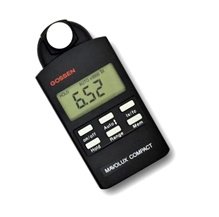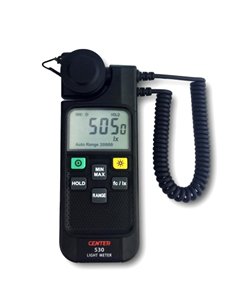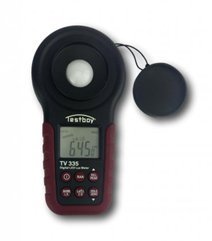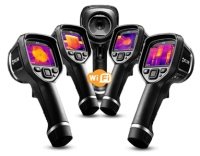Lumens, Lux, Footcandles – All the Lighting Terms You Need to Know

Light meters measure light. You’d think it’s not that complicated - or is it? In practice, the truth may surprise you.
While light meters seem straightforward, glance at a specification sheet, and you could easily become overwhelmed. So to spare you wasted time and any confusion, our scientists have put together a summary list of the ten most needed definitions of lighting terms.
The 10 Most Needed Lighting Terms
1. Luminous Flux
Luminous flux is the measure of the perceived power of light. More specifically, it is energy radiated over wavelengths visible to the human eye.
2. Lumen
The lumen is the SI derived unit (International System of Units) of luminous flux. It is a unit of total visible light emitted by a light source per unit of time. The term refers to light radiated in all directions from its source.
3. Lux
Lux is a unit of light intensity. It is equal to one lumen (see definition #2 above) per square meter. Generally, Lux measurement is the term used where the metric system is used, whereas Candela and Footcandle (see below) is used where the imperial measurement system is used.
4. Candela
A Candela unit is an empirical measurement unit of luminous intensity. For reference, a typical wax candle produces light with a luminous intensity of roughly one Candela.
5. Footcandle
A footcandle is another unit of light intensity. One footcandle is the illuminance cast on a surface by a one-candela source that is one foot away.
6. Spectral Sensitivity
Spectral sensitivity refers to the relative efficiency of a light meter to detect light. The reference for the spectral sensitivity scale is the average capacity of the human eye. The agreed maximum spectral sensitivity of the human eye under daylight conditions is at a wavelength of 555 nanometres (nm), while at night, the peak shifts to 507 nm. Figure 1 (below) shows the spectral sensitivity peak at 555nm.
7. Luminosity Function/Luminosity Efficiency Function
This definition describes the spectral sensitivity of average human visual perception of brightness. Different luminosity functions apply under different lighting conditions. Some specifications refer to the luminosity function as the “photopic luminosity function.”
8. CIE Photopic Spectrum/Curve
Humans perceive light through a spectrum of colours, from long-wavelength reds to short-wavelength purple. The CIE photopic luminosity function (y(λ) or V(λ)) is a standard function established by the Commission Internationale de l'Éclairage (CIE).
This function is used to convert radiant energy into luminous visible energy (light). Figure 1 below depicts the CIE Photopic Spectrum.

Figure 1 The CIE Photopic Curve with the daylight spectral sensitivity peak around 555nm
9. Cosine Accuracy/Directional Response
Directional Response refers to how a meter detects light that lands on a metering sensor at different angles. Cosine accuracy or correction refers to the human perception of light incidence on a surface.
What does this mean? Well, light from above is perceived by a human to be brighter than light emitted at lower angles. Because professionals use light meters for health and safety applications, these devices can have cosine correction built into their processors to correct results based on the angle of the light collection - neat!
10. Photodiode Definition
A photodiode is a semiconductor that translates incoming light to an electrical current. Such conversion is possible because a light meter’s sensor conducts electrical current directly proportional to the amount of light it measures. This functionality enables a meter to convert the energy collected into a numerical reading.
BONUS # 1: What to Look For in a Light Meter
1. Accuracy: You may need a more or less accurate meter depending on your desired use. A meter used for professional testing or verification purposes will need greater accuracy than a meter for home or casual use.
2. Intended use: Not all light meters are created equal. Check that the light meter you are using or wish to use is suitable for your application. The most common issue is that not all light meters can measure LED lighting, which needs a specific type of light meter for this job.
Why?
Measurement difficulties can arise because different light sources (e.g., incandescent, LED, and fluorescent) produce light differently. Therefore, you need to match each spectral profile with a specific type of light meter sensor.
3. Additional features: If your budget allows, some light meters have an assortment of useful additional features such as data logging and data download capabilities.
4. Cosine Correction: For greater accuracy, certain applications may demand a light meter equipped with cosine correction, a feature that adjusts the angle your meter collects light.
Bonus #2: Light Meter Examples
To help demonstrate the variety of light meters and their measurement capabilities, your Instrument Choice team has prepared representative examples of light meters and detailed their specifications.

Lightmeter
|
| Budget-friendly, flexible and ideal for measuring a range of indoor light Sources Click here for more on the IC-CENTER530 Lightmeter. |

Testboy TV 335 Digital LED/Lux Meter
|
| A light meter that ticks all the boxes for indoor lighting investigations - Get all the Testboy TV 335 features and specifications here. |

MAVOLUX Compact 5032-7
|
| Measure almost any light source with the feature-rich MAXOLUX IC-M502C Review all features and specifications. |
The Final Word
That rounds out the top 10 asked about lighting terms. By referring to our list of light meter definitions, you can quickly understand the key terms needed to make informed decisions about selecting and using light meters.
If we haven’t explained a lighting term for a problem you currently face, if you are unsure about any of the definitions listed above or need advice on the best light meter for your application, please feel free to contact an Instrument Choice Scientist!
Call 1300 737 871 or email us [email protected].
Also interesting
FLIR is renowned for innovation in the thermal imaging market and thermal cameras suitable for any application.
This article introduces some of the best FLIR thermal cameras - from new sensors that plug into your smartphone to handheld units and high-precision professional monitoring tools.
Get acquainted with the range of thermal cameras by FLIR

The Testo Saveris 2 – T1 Single Channel Wireless Data Logger is a flexible, reliable and straightforward solution for monitoring and measuring ambient temperature. The logger has a built-in temperature sensor and relays collected temperature information to the Testo Cloud via WIFI.
The Testo Saveris 2 – T1 is ideal for the long term monitoring of ambient temperature in warehouses, buildings, server rooms and offices.
Get your step-by-step Testo Saveris 2 - T1 set up guide here


